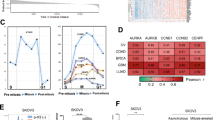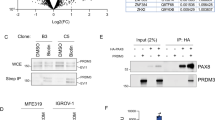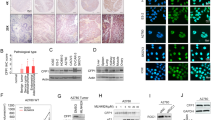Abstract
The IMP (IGFII mRNA-binding protein) family comprises a group of three RNA-binding proteins involved in the regulation of cytoplasmic mRNA-fate. Recent studies identified IMP proteins as oncofetal factors in various neoplasias, but knowledge of a potential role in ovarian carcinomas is still lacking. The immunohistochemical analysis of 107 ovarian carcinomas, 30 serous borderline tumors of the ovary and five normal ovaries revealed de novo synthesis of IMP1 in 69% of ovarian carcinomas. Elevated IMP1 expression was observed preferentially in high-grade and high-stage cases and was a significant prognostic indicator for reduced recurrence-free and overall survival. Phenotypic studies in ovarian carcinoma-derived ES-2 cells demonstrated that IMP1 knockdown affects proliferation and cell survival. Reduced proliferation was associated with decreased c-myc mRNA half-life, suggesting IMP1 as an oncogenic factor that is involved in promoting elevated proliferation by stabilizing the c-myc mRNA in ovarian carcinoma cells.
This is a preview of subscription content, access via your institution
Access options
Subscribe to this journal
Receive 50 print issues and online access
$259.00 per year
only $5.18 per issue
Buy this article
- Purchase on Springer Link
- Instant access to full article PDF
Prices may be subject to local taxes which are calculated during checkout




Similar content being viewed by others
References
Chen CH, Shen J, Lee WJ, Chow SN . (2005). Overexpression of cyclin D1 and c-Myc gene products in human primary epithelial ovarian cancer. Int J Gynecol Cancer 15: 878–883.
Dimova I, Raitcheva S, Dimitrov R, Doganov N, Toncheva D . (2006). Correlations between c-myc gene copy-number and clinicopathological parameters of ovarian tumours. Eur J Cancer 42: 674–679.
Farina KL, Huttelmaier S, Musunuru K, Darnell R, Singer RH . (2003). Two ZBP1 KH domains facilitate beta-actin mRNA localization, granule formation, and cytoskeletal attachment. J Cell Biol 160: 77–87.
Gu L, Shigemasa K, Ohama K . (2004). Increased expression of IGF II mRNA-binding protein 1 mRNA is associated with an advanced clinical stage and poor prognosis in patients with ovarian cancer. Int J Oncol 24: 671–678.
Hansen TV, Hammer NA, Nielsen J, Madsen M, Dalbaeck C, Wewer UM et al. (2004). Dwarfism and impaired gut development in insulin-like growth factor II mRNA-binding protein 1-deficient mice. Mol Cell Biol 24: 4448–4464.
Huttelmaier S, Zenklusen D, Lederer M, Dictenberg J, Lorenz M, Meng X et al. (2005). Spatial regulation of beta-actin translation by Src-dependent phosphorylation of ZBP1. Nature 438: 512–515.
Ioannidis P, Kottaridi C, Dimitriadis E, Courtis N, Mahaira L, Talieri M et al. (2004). Expression of the RNA-binding protein CRD-BP in brain and non-small cell lung tumors. Cancer Lett 209: 245–250.
Ioannidis P, Mahaira L, Papadopoulou A, Teixeira MR, Heim S, Andersen JA et al. (2003). CRD-BP: a c-Myc mRNA stabilizing protein with an oncofetal pattern of expression. Anticancer Res 23: 2179–2183.
Ioannidis P, Mahaira LG, Perez SA, Gritzapis AD, Sotiropoulou PA, Kavalakis GJ et al. (2005). CRD-BP/IMP1 expression characterizes cord blood CD34+ stem cells and affects c-myc and IGF-II expression in MCF-7 cancer cells. J Biol Chem 280: 20086–20093.
Ioannidis P, Trangas T, Dimitriadis E, Samiotaki M, Kyriazoglou I, Tsiapalis CM et al. (2001). C-MYC and IGF-II mRNA-binding protein (CRD-BP/IMP-1) in benign and malignant mesenchymal tumors. Int J Cancer 94: 480–484.
Kobel M, Gradhand E, Zeng K, Schmitt WD, Kriese K, Lantzsch T et al. (2006). Ezrin promotes ovarian carcinoma cell invasion and its retained expression predicts poor prognosis in ovarian carcinoma. Int J Gynecol Pathol 25: 121–130.
Lemm I, Ross J . (2002). Regulation of c-myc mRNA decay by translational pausing in a coding region instability determinant. Mol Cell Biol 22: 3959–3969.
Liao B, Patel M, Hu Y, Charles S, Herrick DJ, Brewer G . (2004). Targeted knockdown of the RNA-binding protein CRD-BP promotes cell proliferation via an insulin-like growth factor II-dependent pathway in human K562 leukemia cells. J Biol Chem 279: 48716–48724.
Livak KJ, Schmittgen TD . (2001). Analysis of relative gene expression data using real-time quantitative PCR and the 2(-Delta Delta C(T)) Method. Methods 25: 402–408.
Mueller-Pillasch F, Pohl B, Wilda M, Lacher U, Beil M, Wallrapp C et al. (1999). Expression of the highly conserved RNA binding protein KOC in embryogenesis. Mech Dev 88: 95–99.
Nielsen J, Christiansen J, Lykke-Andersen J, Johnsen AH, Wewer UM, Nielsen FC . (1999). A family of insulin-like growth factor II mRNA-binding proteins represses translation in late development. Mol Cell Biol 19: 1262–1270.
Noubissi FK, Elcheva I, Bhatia N, Shakoori A, Ougolkov A, Liu J et al. (2006). CRD-BP mediates stabilization of betaTrCP1 and c-myc mRNA in response to beta-catenin signaling. Nature 441: 898–901.
Ross J, Lemm I, Berberet B . (2001). Overexpression of an mRNA-binding protein in human colorectal cancer. Oncogene 20: 6544–6550.
Shih Ie M, Kurman RJ . (2004). Ovarian tumorigenesis: a proposed model based on morphological and molecular genetic analysis. Am J Pathol 164: 1511–1518.
Sparanese D, Lee CH . (2007). CRD-BP shields c-myc and MDR-1 RNA from endonucleolytic attack by a mammalian endoribonuclease. Nucleic Acids Res 35: 1209–1221.
Vikesaa J, Hansen TV, Jonson L, Borup R, Wewer UM, Christiansen J et al. (2006). RNA-binding IMPs promote cell adhesion and invadopodia formation. EMBO J 25: 1456–1468.
Yaniv K, Fainsod A, Kalcheim C, Yisraeli JK, Zhang Q, Oberman F et al. (2003). The RNA-binding protein Vg1 RBP is required for cell migration during early neural development. Development 130: 5649–5661.
Yaniv K, Yisraeli JK . (2002). The involvement of a conserved family of RNA binding proteins in embryonic development and carcinogenesis. Gene 287: 49–54.
Yisraeli JK . (2005). VICKZ proteins: a multi-talented family of regulatory RNA-binding proteins. Biol Cell 97: 87–96.
Acknowledgements
We thank Dr Schmidt, Tumor centre, Martin-Luther-University, Dr Lantzsch, Elisabeth Hospital Halle, Dr Wolters, Hospital Merseburg and Ms Westhusen, local population registry for providing patient data as well as Ms Beer and Ms Grosse for excellent immunohistochemistry. This work was supported by funding to Steffen Hauptmann and BMBF funding (FKZ 01ZZ0404) to Stefan Hüttelmaier.
Author information
Authors and Affiliations
Corresponding authors
Additional information
Supplementary Information accompanies the paper on the Oncogene website (http://www.nature.com/onc).
Rights and permissions
About this article
Cite this article
Köbel, M., Weidensdorfer, D., Reinke, C. et al. Expression of the RNA-binding protein IMP1 correlates with poor prognosis in ovarian carcinoma. Oncogene 26, 7584–7589 (2007). https://doi.org/10.1038/sj.onc.1210563
Received:
Revised:
Accepted:
Published:
Issue Date:
DOI: https://doi.org/10.1038/sj.onc.1210563
Keywords
This article is cited by
-
Elevated expression of the RNA-binding protein IGF2BP1 enhances the mRNA stability of INHBA to promote the invasion and migration of esophageal squamous cancer cells
Experimental Hematology & Oncology (2023)
-
IGF2BP1 induces neuroblastoma via a druggable feedforward loop with MYCN promoting 17q oncogene expression
Molecular Cancer (2023)
-
RNA binding protein IGF2BP1 synergizes with ETV6-RUNX1 to drive oncogenic signaling in B-cell Acute Lymphoblastic Leukemia
Journal of Experimental & Clinical Cancer Research (2023)
-
The role of insulin-like growth factor 2 mRNA binding proteins in female reproductive pathophysiology
Reproductive Biology and Endocrinology (2022)
-
RNA-binding proteins in ovarian cancer: a novel avenue of their roles in diagnosis and treatment
Journal of Translational Medicine (2022)



